Flowing out of a discussion of how we got into kites, I realized my journey was a much longer, winding path than many. I figured I could put together a bunch of posting and questions about “what was your first kite?” and “why do you have what you have in your kite bag?“, into a more comprehensive story. It may be a little long for some people, but here’s the story.
Some Kites I Only Slightly Remember
I got my first kites in the 1980s as a young kid. Single line, generally bright plastic, cheap line, and easily broken. I remember flying the old Gayla Bat and Sky Eyes. I remember going to the old K-Mart and looking through their stock. I remember getting a winder, it was a bright red handle and yellow spool with a crankshaft, with a locking clip that clicked when winding up and could be pressed with my thumb to release the line. I used that winder for a couple years, until several of the metal parts were bent from stress and the plastic wheel had started to wear down from rubbing. I remember a few times flying those kites with my brothers, my friends, or sometimes with my Dad, but almost always I ended up flying alone.
I know I had two different plastic dual line kites, but none of them individually really stood out to me by name. I recall one had a tie-die look, I seem to remember the other was mostly white. Someone with a good memory or catalog of the cheap kites in 1985-1987 could probably help me identify them, but I don’t feel the need.
I had two places I could fly. There was a weed-covered field just down the road, about a 1000 foot / 250 meter walk from the front door over to the field. I had always heard of it as the Penny’s field. In theory it was going to be where a mall, but the mall development fell through in the 1970s, only the JC Penny’s store was built and was open, the field remained a vacant lot my entire childhood. There was also the high school field a half mile away, easily reached with a walk or bike back in the era of free-range kids. Basically the choice was weeds (which also served as a launching stand) or clear grass on the schoolyard.
I’d typically walk over to the field and set up the kite. I’d stand the kite up on some weeds, or maybe a baseball stop if I was at the school and it was the right direction, and walk back over to the handles. If I was lucky the kite would stay standing, upright, if I was unlucky I’d need another walk back over to the kite. This was in the years before kite standoffs, which solved most of the problem. I’d eventually get the kite up in the air, and fly figure 8’s and boxes for an hour or two between school getting out and dinner time. It was the 80’s and as kids we were basically unsupervised until 6. I remember a few times I was up flying in the field when my dad got off work, he would see it and walk out to me in the field instead of going straight home.
The other thing I remember about these old, plastic kites is they kept breaking on hard crashes and lines were annoying when tangled. Sometimes they would come unglued from the spars after a hard crash, other times the stuff — I don’t know if it was a square tube of plastic or fiberglass, would break and the entire kite needed to be thrown out. They were pretty cheap, and I don’t think my mom minded the rate I was going through them, since it was clear I was out using them with actual outdoor use rather than getting dust or abusing them.
That’s a rule for all kite fliers: If you don’t break it, you aren’t flying it. A well-loved kite will need repairs and maintenance. I learned that lesson young.
The First Kites I Can Actually Name
About 1987 while my brother was out serving a mission for the Church of Jesus Christ of Latter Day Saints, he bought two sport kites, two Flexifoil stackers. Since he couldn’t keep them with him while out in service, he had them shipped home for when he was done. They were exciting to see in the air, faster and much stronger than my limited experience. The order caused us to start getting regular catalogs from Catch the Wind. I would sit and study those catalogs for hours.
My parents wanted to reward my piano practice and offered to buy a prize for hitting enough practice days. Twice I selected kites as my prizes. The first one was a small parafoil with a bright ribbon tail. It was my most frightening purchase since I had to call it in and read off my parent’s bank card information (terrifying for a 10-year-old) and then waited for what seemed like forever. I loved the parafoil, and it still gets airtime 26 years later. After it arrived, I really wanted a dual line as my next reward target, so a few months of daily piano practice later and I was the proud owner of a blue Catch the Wind generically-named dual line sport kite, with carbon fiber spars, including an inner spar for higher wind strength, and some pale blue SpiderLine, an early brand of spectra line which was only beginning to replace Kevlar lines. I struggled over of what color to get, settling on a navy blue kite.
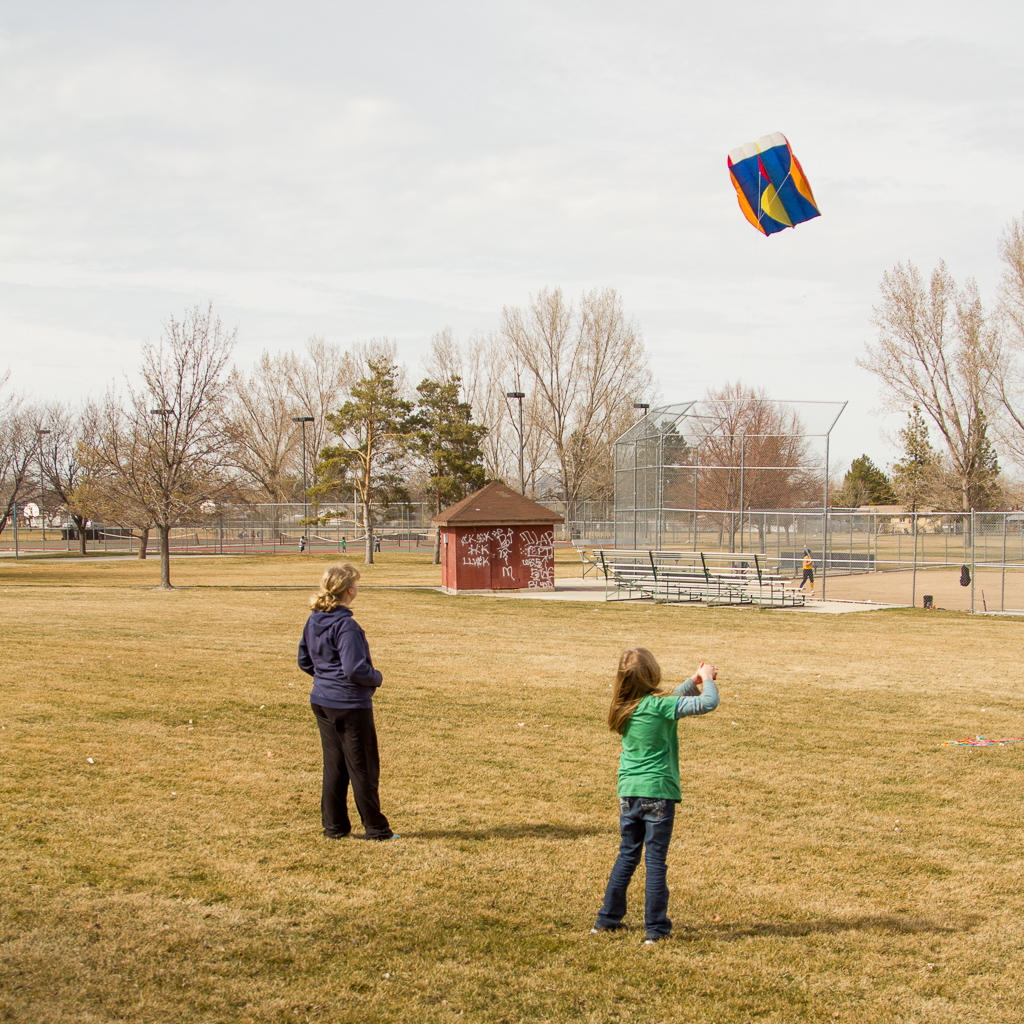
For me, these are what I consider my own kites #1 and #2. They are sentimental and I still carry them in my vehicle to this day.
I kept eying the SpiderKites (by the same company that made SpiderLine, cross branding is fun) they were a series of kite sails and frames that were interchangeable to let you fly in any wind conditions. I also saw the introduction of Revolution Kites. They looked incredibly expensive, I seem to remember them as about $600 for the gear — roughly $1500 equivalent in 2023’s dollars — far more than I could afford, but the pictures were entrancing.
As my interests changed and I started to notice girls and program bigger video games and screen savers, my kites were flown less and less. I kept wanting to fly, wanting to travel to kite shows that I had read so much about, but it seemed just a hobby I might want to merely keep an eye on.
Years passed. I married and finished school. We had children. The kite interest never really went away. I kept both kites in my vehicle, my wife knew about them when we were dating and I flew a bit, just a little a few days a year. Occasionally as we traveled I’d pull out the parafoil and we’d fly. Somewhere along the line I lost the spreader bar for the dual line, and substituted with a wooden dowel. It still worked, and I still remembered my days wanting to fly the big kites, but never felt justified in spending the money.
Re-igniting the Kiting Urge
Skip a few years to October 2013. I heard on the radio about a kite show being held locally, at the Antelope Island Stampede Festival. I remembered all the times reading up about kite shows far away, and realized I wanted to go since this was nearby. There were people flying the kites like I used to fly, and the Revolution kites were being flown in amazing team formations, but everything still felt like far more money than I would feel justified in spending. I didn’t know them at the time, but it was the final performance of Team iQuad.
At the same time, there was a lot of turmoil in my own life as I was re-discovering what interests I had. Following the advice of my head-shrinker, I was starting to spend some money on my own wants and desires instead of turning everything I earned into the family budget. That coupled with bonuses so I had a little bit of money I could start buying things. I had shifted interests over more expensive hobbies like photography so I knew I had a bit of money I could spend. I wanted to get involved in kites again, but still had no idea how to do anything, or what kites to get.
The following year we scheduled a trip to Oregon and Washington beaches, with days that coincided with the Lincoln City Kite Festival. While much of it was familiar, I saw something new. Someone was flipping a dual line kite around in ways I couldn’t imagine, I wasn’t completely sure if it was intentional or accidental, but it looks like it was kept in control as it flipped and bounced in the air. This was my first time actually seeing slackline tricks. Although I had my kites out, flying my old blue dualie and my parafoil, I had to get a kite that could do some of those amazing things. I also still wanted a quad line kite — a thing I had dreamed about for over 25 years — but I still couldn’t bring myself to spend the money. So I bought my first intermediate-skill dual line kite, a Gomberg ZigZag along with some fresh Spectra lines.
So that’s Kite #3 I still carry around, my ZigZag.
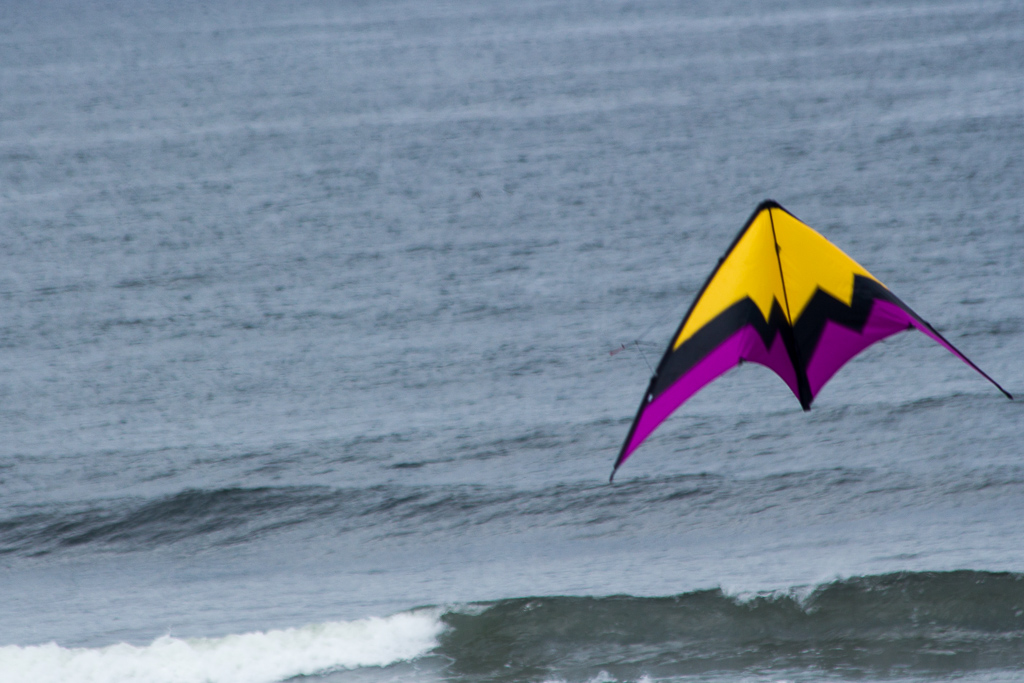
Flying the dual line was fun, but I quickly realized I wanted to satisfy the itch that had been there since I was a ten-year-old. I knew my emotions wouldn’t be satisfied until I had built up some skill on the quad line kites. When I checked the prices, they were far cheaper than years before. While they weren’t cheap, they were something I could afford.
I went online and asked questions. I tried to figure out which wind levels I needed, tried to understand what was meant by mid-vent and full-vent kites, how much winds they needed, how many wraps of spars I wanted, and so much more. Then I had to pick out the color scheme. I wanted a full quiver (3+ matching kites across the full wind range) but my budget wouldn’t allow for it.
Many months later I had enough money available to get what I wanted. So in September 2015, I finally ordered two B-series, a standard sail and a mid-vent. That’s makes kite #4 and #5.
I figured I’d keep logs on these kites to see how much I actually flew them. The first time trying to fly a quad-line kite was September 16th, a wet Wednesday and I was done with work for the day. I spent an hour alone in the field trying to get it set up. When I finally managed to launch it, the kite rose a few inches, and promptly flipped it over. I walked out, stood it up, and flipped it over again, tried setting it against a fence, and ultimately I couldn’t figure out how people were making the kites stand up, and laying it against a fence wasn’t working. I hadn’t yet figured out about ground stakes nor did I know how to make it do the magic I had seen other people do, so off to the web to watch videos and try to figure things out. My kite log entry was “Lots of crashes, wet grass”.
The next day, Thursday. I was out again for an hour trying to apply what I had seen in videos. My kite log entry was simply “More crash” for another hour. This time I used a screwdriver as my stake, so I could actually get a little air time. Even so, another hour alone in the field, back and forth from kite to handles after each crash.
The following Monday I was out there again and had some success, with the log “Up downs”. I spent three hours alone on the field trying to figure it out, and in the end I had achieved launching and landing. I knew I was hooked.
By may of 2016 I had accumulated over 30 hours of flight. I had basic control and it felt amazing. I also had money to complete the series with a full vent, Kite #6.

This was a good place for kites for a while. I was flying about once a week, weather permitting, for about two hours at a time.
I could not afford the trip out to kite festivals, I couldn’t justify traveling over a thousand miles just to watch people fly kites, but I could go out to the field with my family and put a kite in the air.
When I moved to Austin, Texas for work in 2016 I had just missed the South Padre Island (SPI) Kite Festival, so my first local festival was the Texas City Kite Festival. I was hoping that all kite festivals were like the ones I had experienced so far, and my hopes were dashed. While I was at the festival I met one other person who was able to fly sport kites, but I never knew who we was nor did I record his name, so it is lost in history. I was told there was a group in Austin, now I know them as Austin End of the Line kite team, but he didn’t know their name nor where they met. I had seen postings that there was a group that tried to meet monthly, emails bounced and each month their field was empty. It was a great field, though, and my kite flying practices jumped from every weeks to being often twice-weekly. Even so, it was all self-directed and alone.

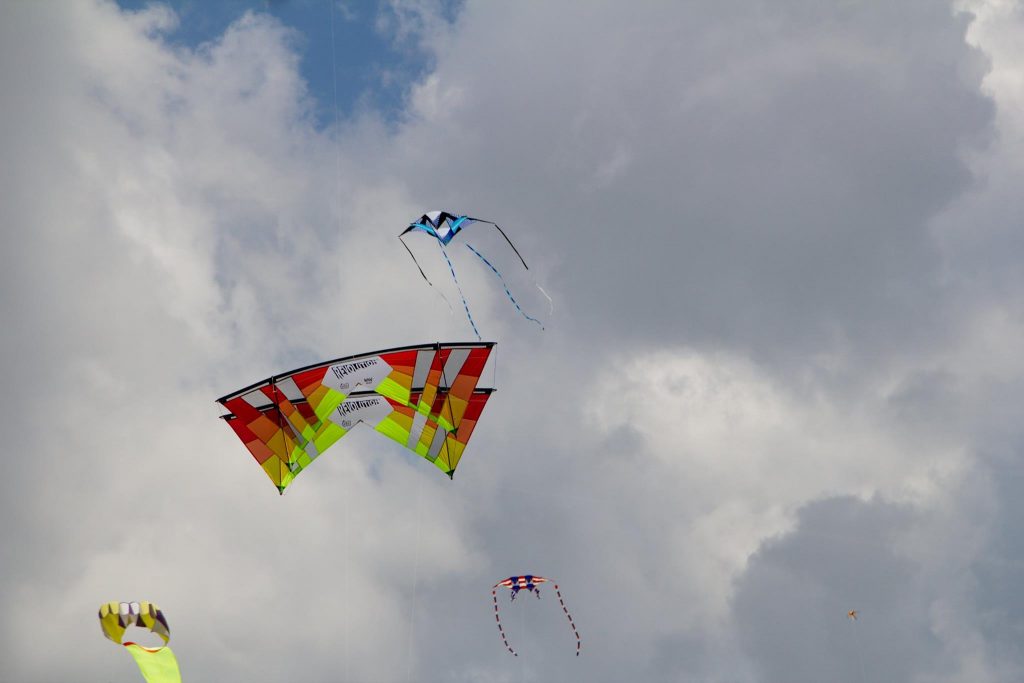
In 2017 I traveled to the SPI Kite Festival and didn’t know I needed tickets for the indoor session, so we enjoyed the outdoor flying. That was more of what I expected in a kite show. I saw lots of outdoor kites, and it inspired even more kite flying. I tried to fly off in the corner, but it wasn’t very remarkable. I also learned there were groups who arrived the days before and stayed the weekend after, but I didn’t have the room and we had other commitments, so my own flying was limited to some time on the beach off to the side.
After that, Revolution came out with a new product. I was curious and bought a Purple Revolution Reflex, which was kite #7. It was a birthday present to myself. While it flew well enough, I didn’t like it as much as my B-series. Even so, since I had three sets of lines and handles it worked well as a second kite so I could fly a second full-sail kite with a family member, rather than always being mismatched.
My mom noticed my growing interest in kites and wanted to be useful, so ended up buying some Costco single line kites that were well built but not what I’d fly. Even so, they were solidly built. I realized they would be great to let kids fly rather than handing over my nice kites that have a steep learning curve. So they became #8 and #9, a parrot and a butterfly. They are rarely flown, but I’ll pull them out with young nieces and nephews or at group events where I know there will be young kids.
Buying More than Just Kites
Late in 2017 I saw that John Barresi would be running a Quad Clinic at the February 2018 SPI Kite Festival, so we bought tickets for the indoor session of the festival, I paid to register in the clinic, and kept working on my own flying. While I had the basic maneuvers down by this point, I had only recently mastered the inverted hover, and was trying to understand how to do a bicycle spin. Nearly all my learning was through YouTube videos, and I figured if the only thing I could learn at the clinic was the Bicycle Spin it would be worth it. I had shared a few videos of my flying with people online to try to troubleshoot problems, but it was all on a MiniDV camcorder, transferring off the tape was slow, and posting online was slow and difficult. I was thrilled to have the prospect of a festival.
The 2018 SPI Kite Festival was the most engaged I had been at a kite event. Even though I was still a spectator, I was at the sidelines trying to learn everything I could. When I wasn’t watching, I was flying next to the flying field trying to copy their team maneuvers, standing upwind as I copied the elements with the pros in my backdrop. I’d read the team flying guides on how to do team flies, but I knew my skill wasn’t to the point to join in on their megafly. I really wanted to, all the way deep down inside I desperately wanted it, but I knew I wasn’t there yet. On the last day of the festival, as I was off to the side flying on my own but as people were packing up and the crowds leaving, John landed his new experimental kite next to mine. My wife had just asked if I was ready to leave yet, and when John landed I called back “No, I’m not ready any more.” We chatted briefly, John told me he liked what he saw, and introduced me to some more advanced flying and a few calls. This was my first time actually crossing lines with another kite pilot, and it was thrilling.
The Quad Clinic is what John calls the Quad 101, starting with the anatomy of the kites and basics of kite flying, through the mechanics, then with personal time for the rest of the day to teach at whatever level everyone is at. One of the most frustrating things about my learning goals was that there was very little to offer. Apart from some minor corrections by John and the rest, it was basically “it looks like you’re doing everything right, you just need more time at it.” John offered a few tips, rocking back and forth can help, moving slowly and deliberately at each stage can help, but ultimately this was mostly about developing a feel for it. Even so, he helped me with a bunch of tiny issues I didn’t know I had, lots of little corrections here and there, and I feel I got my money’s worth from the clinic. I also ended up getting some time with Brett, Eli, and Scott on the team, who helped nudge me in several directions to increase my skills.
Expanding Skills Require Better Gear
I know from other hobbies there are some common limiting factors. Sometimes the limiting factor is the person’s skill, other times the limiting factor is the gear. With all my practice, as good as my dual line ZigZag was I knew I was reaching the limit of what I could make it do. I needed a good teacher (which I still hadn’t found) but also needed additional, better gear. This lead to three more dual line kites, each for different purposes.
I purchased #10 my Indoor Kaiju black and green, #11 my blue Kymera, and #12 my blue Hydra, all dual line kites. John had only recently announced the Kaiju, an indoor dual line kite. The Kymera and Hydra were going on clearance as Into The Wind was discontinuing them, but they remained pretty good kites purchased at half off. Higher-end gear was more expensive, but it was still good stuff.
These kites opened up a few new options. I was in a church building with a gym twice a week, and it was a perfect place to fly my new Kaiju and try to learn indoor flight. The Kymera and Hydra are fairly similar but with slightly different handling. The Hydra makes tighter turns, and was the most amazing I had experienced with anything resembling tricks, where the Kymera handles smoothly all the way out to the edge and has a bit more precision. The Kymera also makes a noise I didn’t really like at first, it has no leach lines and I thought I might have set it up wrong. After some chatting online, I liked the idea that it was the kite blowing raspberries at the crowd with a loud “PTTHHHH!” as you do a long ground pass.
Now that I was getting some indoor dual line practice, I realized I wanted to learn indoor quad line kite too. Later in the fall I purchased a green indoor Revolution. This was my first built-to-order kite and Lolly said they’d waive the custom fee since it was a color pattern they occasionally sold. So that became #13.
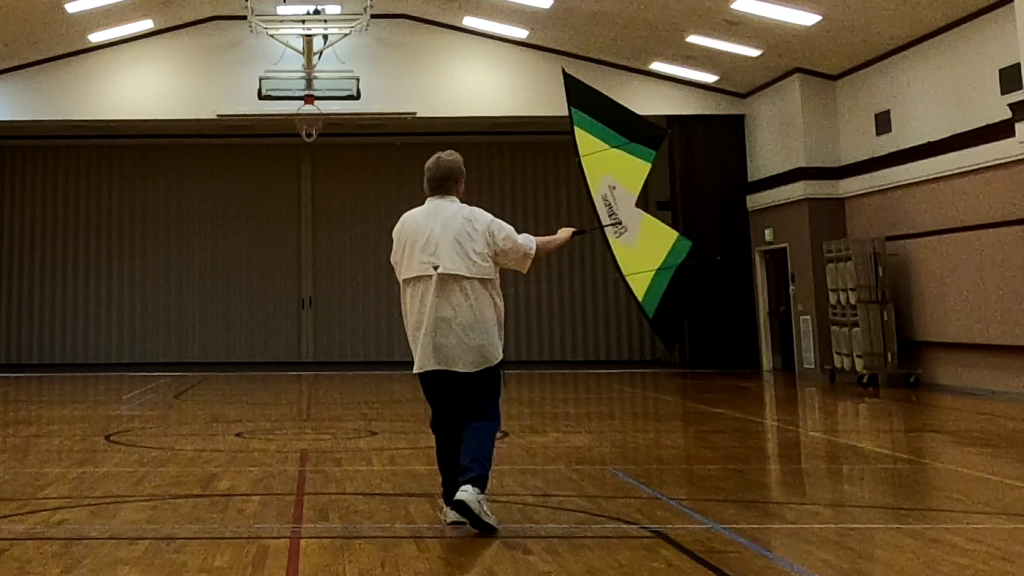
Near the end of 2018, John’s experimental kite became the Djinn, so I purchased the full sail and mid-vent kite when they came out, #14 and #15. When I had saved up a little more, the full vent became #16.
At this point I still had no luck unlocking any slackline tricks. I could launch, fly corners and turns, and land on the edge of the window well enough, and I had the basics of speed control down, but I struggled to do more than that.
At one of the practices for Austin End of the Line I showed up and asked for a bit of help. None of them really did that kind of flying but Michael Boswell had a little experience and helped me get a rough axel out. Instead of stalling mid-window, flying to the edge, using the edge to stall it, and when coming back into the wind use the pressure to make the flip. It sometimes worked, but it really didn’t unlock anything. More often than not I ended either as a sloppy turn or snagging a wingtip and tumbling out of the air.
I asked questions of people at SPI but most people didn’t know, they were either beginners knowing less than myself, quad fliers, or straight-line team fliers. I was terrified that nobody could help me!
Then I had a lightbulb moment. I knew two people who were both going to be there on the beach. And both were amazing slackline fliers. And I had a kite in my bag designed by each of them. So I set up both my Kymera (designed by John Barresi) and my Hydra (designed by Paul DeBakker), started flying, waited for either Paul or John to show up. Tragically I was mismatched with the person, I was flying the Kymera when I saw Paul deBakker showed up, but I still walked over to him and asked for advice. After a few minutes both on my kite and on his Level One Kites Badass UL, he told me my next step was to really master the stall, I needed to be able to stop moving the kite and master just letting it float anywhere in the wind window. So we practiced the stall for a bit there on the beach, and I added dual line stalls and floats to my practice list.
I wanted to fly dual lines with family members (or with strangers or anybody, really) so I bought a matching green Hydra (kite #17) that was still on clearance for $125 instead of the MSRP $250 and couldn’t find a cheap matching red Kymera. I had waited too long and clearance stock was gone, but ultimately it would work out well enough. Asking more questions to more people about who could fly and help me unlock what was blocking my slackline tricks, I found out that Frazer Worley lived in Austin as well. So I asked him to help me, and one calm morning we met at Old Settlers Park. I thought it was going to be a terrible day with the light, but he picked up the lines to one of my Hydras, said it was a perfect match for the very light wind that morning. He checked out my kites, and even though I struggled with it, he demonstrated axels, half axels, and a few other tricks, commenting he liked how the Hydra felt. He joked that he’d have me doing an Axel in just a few minutes, maybe an hour at most. Two hours later and I managed to do six really sloppy axel-like flops. I felt like a slow learner, but it didn’t matter, I had a motion that would start to unlock the next level for me.
Trying to do more of those axel-like flops, making them consistent, not getting them snagged on the wingtip, and just trying to figure out how the maneuvers worked consumed most of my practice days. More often than not I’d end up on the ground, but I had mastered flipping the kite over and re-launching it from almost all positions, so unless it was nose toward me or badly wrapped, I could flip it around and try again.
I wanted to buy another Kaiju because it was supposed to work well outdoors in light wind and I didn’t want to jeopardize my indoor kite with an outdoor crash. So in addition to the indoor flying I was already doing with my first one, a second Kaiju became #18. The following month, I won another Kaiju in the KiteLife drawing which became #19. I didn’t mind putting two in my outdoor bag and one in my indoor bag, they’re great little kites.

Getting Kites for Other People
I found that I also wanted to do more indoor kite flying and also have it more accessible to family members and friends, and at the same time, I didn’t want to hand over more expensive gear to strangers to break.
I ordered an indoor iFlite #20, an amazing indoor glider that flies super well. One of my daughters nicknamed the kite “snowflake” which works well for a little white kite, so that name stuck. In the order I also picked up a Skate #21, a larger glider that can also fly well outdoor in light wind, so if I’m flying a light wind sport kite like a Kaiju my family members can fly it.
I wanted a dual line parafoil in my bag not for me, but for strangers and for instructing people about them. So I selected a CrossKites Air 2.1m #22, cheaper than the better grade dual line parafoils but still flies well enough. I don’t pull it out often, usually only when I’m more worried that the person will damage a framed kite and they want to fly something with multiple lines.
I also picked up a Quantum, my #23. I almost felt bad making the offer for the used kite, being sure to explain that I didn’t really need the kite and was mostly picking it up for something to be damaged, and that if they had any better offers they really should take them instead. Even so, that seemed to work so it’s now in my bag. Although I didn’t really need it, I’ve seen enough people flying other Prism kites, particularly the Jazz, that when I walked over to them I wanted something in the same kite family but still a full sized kite. It’s enough that they can feel the power of a full sized kite but still inexpensive enough that I’m not handing over a premium kite.
Kites that are Better than Me
The next round of kites I don’t really need, they are definitely a splurge, but they are things that satisfy some wants. They are kites that function beyond my current ability, so they offer room to grow. I’ve also found they do some advanced movements more easily than the lower-grade versions, they are pro-grade kites for good reason. They cost a little more, but they’re premium grade and it shows in every stitch, you can feel it in every movement, and flying them feels like a bit of luxury.
Up to this point I didn’t have an ultralight for outdoor, nor did I have a vented kite for outdoor.
In November 2021, back-to-back, I ended up filling those gaps. I decided to order a vented kite on the 25th, and then three days later I noticed online that Brett Marchel was selling his WidowMaker Pro standard and ultralight kites. Team KiteLife had experimented with them for a while and purchased a matched set, probably among the last made with the Widow NG replacing them. Brett was selling both a UL and a Standard, so these became #24 and #25. They’re black and green.


The vented kite was a custom vented Lam Hoac Sky Devil, white and red with green eyes, my #26. I flew it a bit and realized I wanted a SUL in the same color scheme, so ordered that the following year as #27.
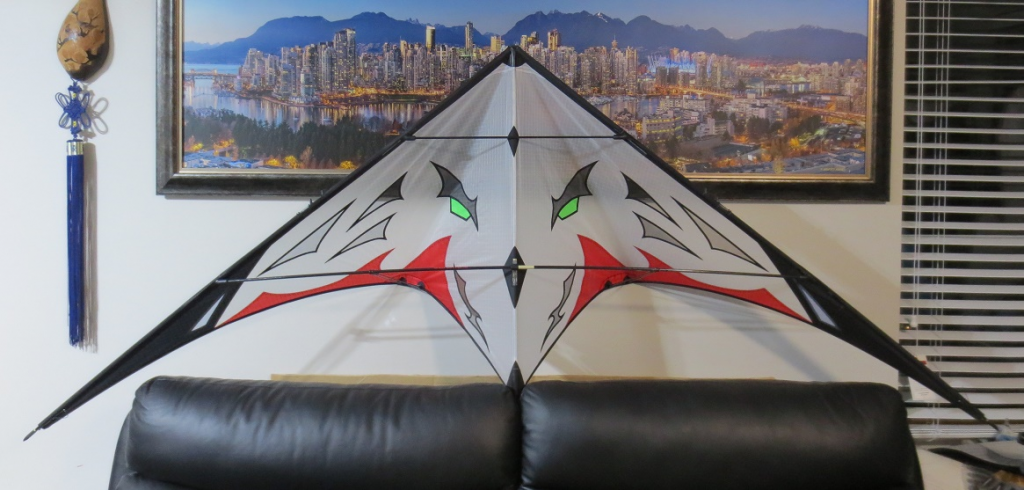
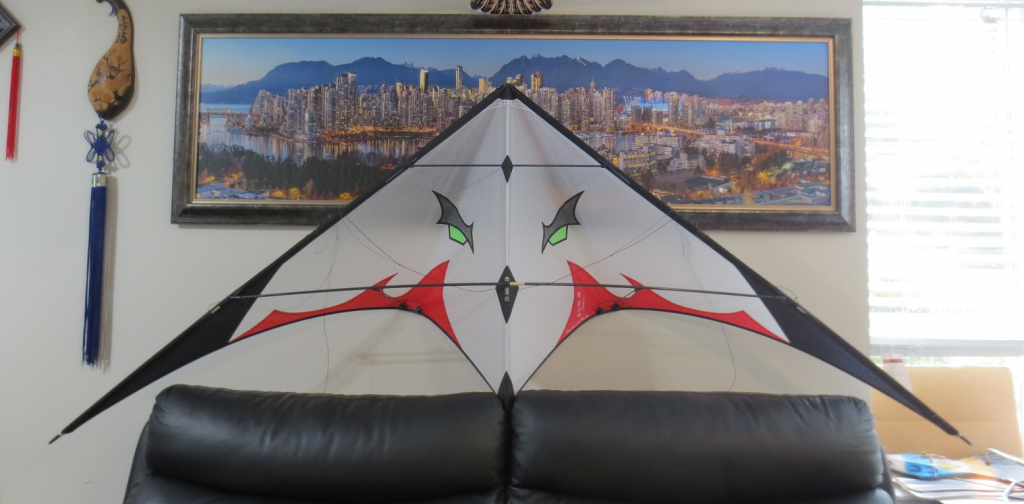
Together, these four gave me a vented, standard, ultralight, and even lighter super ultralight. They are also far above my skill level. I’ve let some real pros handle them and could see them dance through the sky in ways far beyond my ability, so I know the kites are more than capable. They have opened up a new way to grow, although I think I need more mentoring with them.
A while later I noticed that a Facebook group member, Tom Bush, was selling a Sky Devil prototype, Mark 6. (He advertised it as M-VII, but the fabric says “M-VI”.) I had a bit of money and the kite looked beautiful, but I figured I really didn’t need it. One day he lowered the price and I still kept waiting. Finally, I realized that it would be a great addition if nothing else as a piece of history, so I contacted him, arranged a purchase, and drove out. I found out he was selling because of age. It’s hard to know that’s where I will be eventually, old enough that sport kites are out of my ability and wanting to still see the kites in the air, but I appreciate the kite and will use it. This vented sail became #28. While I was there, he told me to wait a bit as he stepped out to storage. He came back in with a small kite sleeve with “lam” on the outside. He opened it up to reveal a black and red Magic Angel, another Lam Hoac creation custom made. Tom was kind enough to say he would offer it if I could give it a nice home, so it is now #29, bringing my total of these gorgeous boutique kites up to four. This M-6 vented handles a little more heavily from the white and red vented, but still looks and feels great in the air and the bit of extra weight feels nice on windier days.

Filling Out the Suite
As the Extreme Vent and Hardcore Vent Djinns were released my skill level was at the point where I wanted them for the extreme weather. I didn’t need them often, but when the wind was howling they were quite needed. Here is an image which includes two of them fitted with LED kite lights I was working on at the time, the 5 in the Djinn family:

The Extra Vent XV and Hardcore Vent HV became #29 and #30. The Ultralight became #31.
Trying some Kite Making
For my LED kites I was struggling with trying to get the lights to stay on or work in a way I was satisfied with. I wanted to have a kite that had the lights strongly attached, but that would likely mean stitching them in place and I didn’t like the idea of spending that much money then stitching through expensive sails. So I built my own for about a quarter the cost, #32 and #33 with the story and pictures here.
After my mom died, I realized I wanted to have some white memorial kites to fly. It is somewhat traditional to fly a white kite for those who have died, and I didn’t have anything I considered close enough. And since you never know what the conditions will be, it means both a standard sail and a vented sail. Those became two white quads, #34 and #35.
Winner Winner Chicken Dinner Free Kite
Most recently, my prize from winning a KiteForge contest was a free kite. The one I chose was a custom Djindoor, the indoor version of the Djinn. Even though it sets me up on a slightly different color palette, I went with a color scheme that I liked. This makes #36.
I now have far more kites than I thought I would have a few years ago. Now you can see how every one of the kites satisfies a specific desire or a niche in my flying. They’re all loved.
The Recap and Current Count
So the tally of my kites to date:
- Single Line: 3 standard, 2 ultralight (UL), 1 super ultralight (SUL)
- 1 Old CtW Parafoil #1
- 2 grandma’s Costco specials #8 #9
- 1 iFlite 2 “Snowflake” #20
- 1 Skate #21
- 1 Lam Hoac Magic Angel #29
- Duals: 8 standard, 2 vented, 2 UL, 3 SUL
- 1 old blue CtW dual line #2
- 1 ZigZag #3
- 2 Hydra #12 #17
- 1 Kymera #11
- 3 Kaiju #10 #18 #19
- 1 CrossKites Air #22
- 1 Quantum #23
- 2 WidowMaker Pro STD & UL #24 #25
- 3 Lam Hoac Sky Devil Vented, UL, and Mark 6 #26 #27 #28
- Quads: 5 standard, 2 SUL, 1 UL, 2 MV, 4 FV, 1 XV, 1HV
- 3 B-series Revs ST, MV, FV #4 #5 #6
- 1 Reflex Rev #7
- 1 Indoor Rev #13
- 6 Djinn UL, ST, MV, FV, XV, HV #14 #15 #16 #29 #30 #31
- 2 homemade LED ST FV#32 #33
- 2 homemade white memorial ST MV#34 #35
- 1 Djinndoor #36
And that’s more than enough kites for all the conditions I fly in, plus another to hand to a friend.